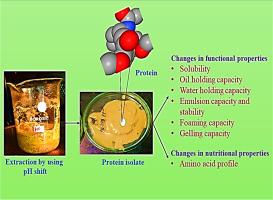植物蛋白质的 pH 值偏移萃取技术:一种有希望实现可持续发展的技术
IF 8
Q1 ENERGY & FUELS
引用次数: 0
摘要
随着人们认识到动物源性食品不健康并与气候变化有关,研究人员越来越关注植物性蛋白质,将其作为一种可持续的替代品。植物蛋白具有多种功能和膳食益处,因此适用于各种食品应用。本研究探讨了碱性和酸性 pH 条件对植物蛋白提取率以及功能和营养特性的影响。植物蛋白的主要来源包括谷物、豆类和油籽,可通过混合来解决必需氨基酸缺乏的问题。从植物来源中提取蛋白质有多种方法,如盐提取法、微波辅助提取法、超声辅助提取法和胶束沉淀法。在这些技术中,pH 值转换法因其非热性质、可持续性和成本效益而脱颖而出。在这种方法中,蛋白质在碱性 pH 值下被溶解,然后在其等电点处沉淀,从而收集蛋白质沉淀。根据定性和定量分析优化提取技术对提高蛋白质产量、特性和营养价值至关重要。大多数传统的蛋白质提取方法都需要大量的化学物质,这就带来了安全处置的问题,影响了环境的可持续发展。传统方法还会产生含有非蛋白成分的蛋白质,增加了另一个纯化步骤,导致总体成本增加。然而,pH 值转换法使用的刺激性化学品相对较少,蛋白质提取率高,因此在环境和经济上更具可持续性。植物蛋白的可持续提取解决了与动物源性食品相关的健康和环境问题,为促进食品工业的可持续发展提供了一个前景广阔的解决方案。本文章由计算机程序翻译,如有差异,请以英文原文为准。

pH shift extraction technique for plant proteins: A promising technique for sustainable development
With the recognition of animal-derived foods as unhealthy and their association with climate change, researchers are increasingly focusing on plant-based protein as a sustainable alternative. Plant proteins offer versatile functional and dietary benefits, making them suitable for various food applications. This study investigates the influence of alkaline and acidic pH conditions on the extraction yield and the functional and nutritional properties of plant-based proteins. The primary sources of plant protein include cereals, legumes, and oilseeds, which can be used to address essential amino acid deficiencies through blending. Several methods have been employed for protein extraction from plant sources, such as salt extraction, microwave-assisted extraction, ultrasound-assisted extraction, and micellar precipitation. Among these techniques, the pH shift method stands out due to its non-thermal nature, sustainability, and cost-effectiveness. In this method, proteins are solubilized at alkaline pH and then precipitated at their isoelectric point, resulting in a collection of protein precipitate. It is crucial to optimize extraction techniques based on qualitative and quantitative analysis to enhance protein yield, characteristics, and nutritional value. Most conventional protein extraction methods require a large quantity of chemicals, which imposes the issue of safe disposal, compromising environmental sustainability. Traditional methods also produce protein with non-proteinaceous constituents, adding another purification step and resulting in increased overall cost. However, the pH shift method utilizes comparatively less harsh chemicals and has a high protein extraction yield, which makes it comparatively more environmentally and economically sustainable. The sustainable extraction of plant-based proteins addresses the health and environmental concerns associated with animal-derived foods and offers a promising solution to promote sustainability in the food industry.
求助全文
通过发布文献求助,成功后即可免费获取论文全文。
去求助
来源期刊

Energy nexus
Energy (General), Ecological Modelling, Renewable Energy, Sustainability and the Environment, Water Science and Technology, Agricultural and Biological Sciences (General)
CiteScore
7.70
自引率
0.00%
发文量
0
审稿时长
109 days
 求助内容:
求助内容: 应助结果提醒方式:
应助结果提醒方式:


